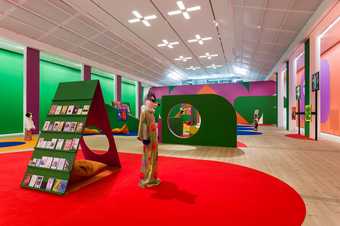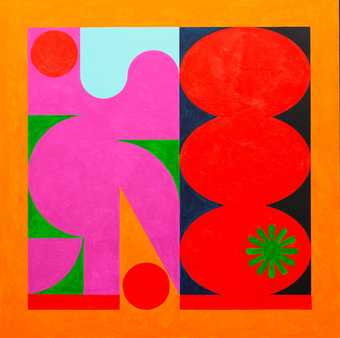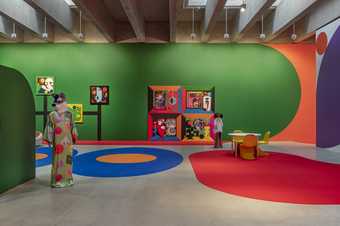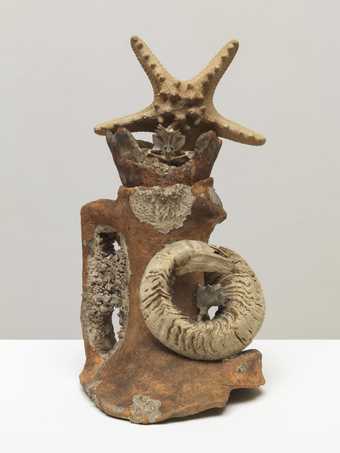
Biosfera Peluche / Biosphere Plush (including the Zine Library) installed at BALTIC Centre for Contemporary Art, 2021-2. Photo © Rob Harris 2021
Ad Minoliti merges ideas from modern art, ethics, science and subcultures in a reflection on modern worldmaking.
Ad Minoliti believes that many worlds exist within each other. ‘Biosfera Peluche’ is one. In this vibrant installation, colour, line, form – and plushness – are the building blocks for everything. The artist has reconstructed the gallery space as a vivid ‘Earthship’ environment that promotes inclusive values and ideas for our society.
‘Biosfera Peluche’ is modelled against late twentieth century experiments that explored if humans could sustain life in environments such as space stations. These projects aimed to generate data and information that could be used to occupy and profit
from other planets. Minoliti’s biosphere overturns the colonial and capitalist ideas behind these social and scientific ventures. Instead of operating on exclusion and profit, Minoliti’s version values all identities, experiences, and even abstract forms. In ‘Biosfera Peluche’, machines and humans co-create artworks, and colour and shape are applied to reform architecture or deconstruct gender roles.
Three trans-species furry creatures inhabit the installation. Through these hybrid ‘Furries’, Minoliti disrupts the binary divisions we often make — between male and female, terrestrial and alien, biology and technology, art and everyday life. The biosphere also hosts the ‘Feminist School of Painting’. This anti-school of art welcomes all ages, bodies, and experiences. The artist invites you to join in with the programme of free classes, to spend time in the reflection areas, or browse the library of queer and feminist zines.
Minoliti’s ‘Earthship’ roams between museum and gallery venues, gathering new ideas from the people who contribute. Developing a ‘peluche’ theory of deconstructing and rebuilding the world through cooperation instead of competition, Minoliti says ‘I hope people enjoy ‘Biosfera Peluche’ as a place for reading, learning, resting, or getting together.’
‘Biosfera Peluche’ is a poetic alternative to rethink and spread caring and tenderness as political issues.
Ad Minoliti
Biosphere
I don’t believe in competitive evolution. Capitalism took Darwin’s ‘survival of the fittest’ and used it to naturalize domination ... I want to create a system where life works on exchange and cooperation.
Ad Minoliti
‘Biosfera Peluche’ is Minoliti’s speculative criticism of Biosphere 2, ‘the world’s largest Earth science experiment’. This monumental biome housed eight white, cisgender people in a ‘closed mission’ in the Sonoran Desert, US (1991–3). Funded by the billionaire oil tycoon Ed Bass, it studied whether humans could sustain life in a sealed environment. It aimed to generate data and knowledge that could be used to colonise space and profit from other planets. The project considered Earth as ‘Biosphere 1’.
For Minoliti, Biosphere 2 reveals the space race as ‘an extractivist and colonising endeavour that enhances the interests of the already powerful’. ‘Biosfera Peluche’ is intended as an antidote to this closed project and its destructive intentions. At this time of climate change and environmental crisis, Minoliti’s imagined biosphere promotes inclusion, community and shared learning, and welcomes everyone to take part.
Abstraction and Invention
Painting is not limited to a technique. It is a visual language that can be manifested with diverse materials.
Ad Minoliti
Minoliti takes abstract landscape painting into outer‑space and other worlds. Colours, lines and shapes transform the gallery architecture and the fabric of social spaces. Trained as a painter, Minoliti is influenced by the modern art history of Latin America. Groups like Arte Madí and Asociación Arte Concreto-Invención (both founded 1944–6, Argentina) broke away from traditional rules. Their work embraced progressive social values and used abstraction to distance their work from the realist imagery used in political propaganda. Their ‘inventions’ (artworks) consisted of simple lines, colours and planes (blocks and shapes). They embraced playfulness, experimenting with irregularly shaped canvases and three-dimensional objects.
Minoliti extends this legacy of geometric abstraction with the spirit of childhood play. On one wall of the installation, six painted circles and a rectangle could be understood as a composition of shapes, but also suggest the face of the moon seen through a window.
Furries and Fashion
I don’t believe we have authority over a natural world, I don’t believe in nature on a different level from human-animals
Ad Minoliti
Three ‘Furries’ bring a mutant dimension to ‘Biosfera Peluche’. These hybrid creatures could be earthbound, alien or other. They reference cartoons and contemporary subcultures made popular by the internet. They have non-binary names and clothing. ‘Osx (Dog)’ wears a sweatshirt with art by Lam Hoi Sin (born 1986, Hong Kong).
Minoliti asks us to think beyond the categorisations that are prevalent in Western attitudes. Bringing together ideas from queer and feminist theory, animalism and childhood, Minoliti’s ‘Furries’ suggest that all identities, orientations and subcultures hold equal agency here.
Space Playset
I don’t strive for exploration of outer space, and even less at the cost of the only habitat we have. My fiction is not fed by a will to reach a possible future, but as a way to criticise what is going on now.
Ad Minoliti
Minoliti is interested in the relationship between gender equality and science fiction, exploration and discovery. These paintings imagine space travel and far-distant settlements that are free from hierarchies and conquests. Part of Minoliti’s ‘Dollhouse’ series 2016, they depict rooms for non-gendered fantasy and play.
‘Space Playset’ reflects on commercial toys that are designed to promote STEM subjects (science, technology, engineering, mathematics) to girls. Minoliti has reduced these popular toys to blocks of shape and colour, rejecting the idea that toys should be suitable for boys or girls. The artist wants to remove this discriminatory gender distinction that upholds heteronormative gender roles.
Minoliti calls these works ‘cyborg paintings’. They begin as a spray-painted image that is digitally manipulated, printed, and then overpainted by hand. Created by both human and machine, the artist seeks to question the distinctions we make between biology and technology.
Fable Series: Butterflies and Flowers

Ad Minoliti Fable (Butterflies and Flowers) 8 2021. Acrylic paint on canvas. Courtesy of the artist
We are shaped by toys and cartoons, and we have to subvert them. I’m still looking to translate how they work in me. Toys can be ageless tools if we want, if we change the usability.
Ad Minoliti
This series of paintings is inspired by the fictional children’s character ‘Sarah Kay’. Created by Australian artist Vivien Kubbos in the 1970s, she represented values of friendship, kindness and the natural world.
‘Butterflies and Flowers’ respond to these cute and camp illustrations. At the time the images became popular, Argentina was oppressed under a violent regime that disappeared young mothers and abducted their children into pro-party families.
Activated in that context, the character of Sarah Kay also upheld conservative expectations about gender roles and socially acceptable behaviours.
Minoliti says ‘I don’t have the answers, I want to invite people to ask the questions, but we know we must abolish the systems of oppression and recognize how they operate on many levels’. By deconstructing the recognisable elements of Sarah Kay imagery and reforming them through shape and colour, Minoliti reappropriates the relationships between people, flowers and animals, without gender restrictions.
Feminist School of Painting Manifesto (concise)
The school is an anti-school
The school welcomes all ages, bodies, experiences and skills
The school promotes cooperation, not competition
The school is colourful in both environment and atmosphere
Approach to ‘doing’:
Classes invite participants to move, use, and claim the space
Classes are open to all and free to attend
Classes are practical (making) and theoretical (thinking and exchanging)
Classes break the binary categories of knowledge
There are no great geniuses of painting: we are all experts and learners
Genres are for playing with. They should not limit us
We have a tool for open dialogue – questioning – always respectfully
Feminist School of Painting Open Workshops
Imagine our universe if this were art history.
Ad Minoliti
Minoliti’s Feminist School of Painting hosts a series of workshops developed by creative and non-art practitioners. They apply ideas from feminist and queer theory to reimagine portraiture, still life and landscape, in relation to power, gender and sexuality.
The experimental sessions involve discussion and practical art activities. They promote creative curiosity, exchange and cooperation, and don’t require any knowledge of art or skills in making to join in.
Workshops are free and open to visitors of all ages. Children are welcome to accompany their adult.
Queer and Feminist Zine Library
‘Biosfera Peluche’ includes a library of queer and feminist zines by a range of authors. You are welcome to browse the library and spend time in the reflection areas. Please return the zines after reading.
‘Zine’ (pronounced ‘zeen’). Derived from ‘fanzine’, a zine is an independent noncommercial booklet, usually self-published and printed in small circulations. Zines grew out of the amateur press movement of the late 19th century, later developed by science fiction enthusiasts and then infused with a grunge aesthetic in the 1970s punk scene. The format has often been adopted by dissident or marginalized individuals and groups as a way to express opinions and ideas.



